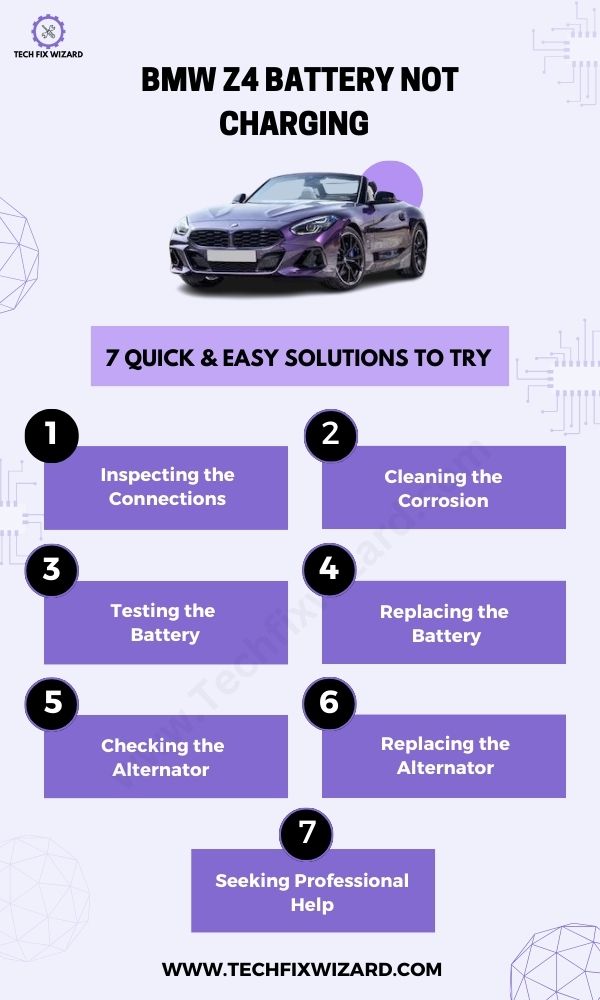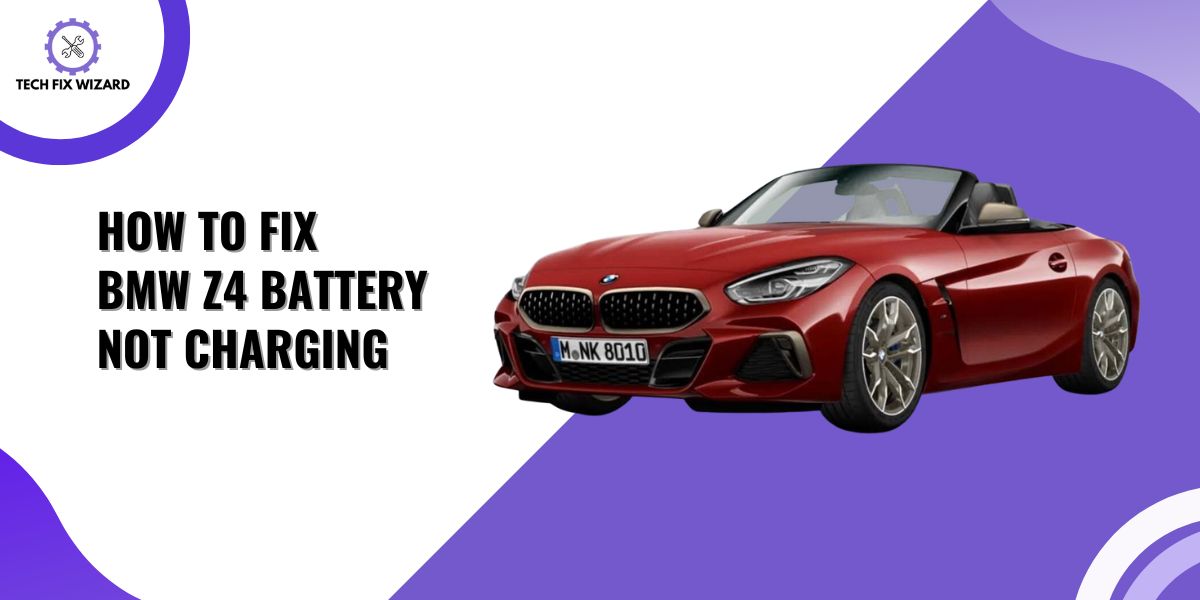Owning a sleek and powerful sports car like the BMW Z4 can be an exhilarating experience.
However, encountering a BMW Z4 battery not charging issue can quickly put a damper on the excitement.
In this article, we will explore some common reasons why your BMW Z4 battery not charging and suggest steps to diagnose and resolve the issue.
Contents
- 1 BMW Z4 Battery Not Charging – Diagnosing the Problem
- 2 Troubleshooting BMW Z4 Battery Not Charging – 7 Steps
- 3 1. Inspecting Connections
- 4 2. Cleaning Corrosion
- 5 3. Testing the Battery
- 6 4. Replacing the Battery
- 7 5. Checking the Alternator
- 8 6. Replacing the Alternator
- 8.1 1. Gather necessary tools and parts:
- 8.2 2. Disconnect the battery:
- 8.3 3. Access the alternator:
- 8.4 4. Remove the serpentine belt:
- 8.5 5. Disconnect electrical connections:
- 8.6 6. Remove mounting bolts:
- 8.7 7. Install the new alternator:
- 8.8 8. Reinstall the serpentine belt:
- 8.9 9. Reconnect the battery:
- 8.10 10. Test the new alternator:
- 9 7. Seeking Professional Help
- 10 Preventative Maintenance Tips
- 11 FAQs
- 12 Why is my BMW Z4’s battery not charging?
- 13 What are the common causes of a BMW Z4 battery not charging?
- 14 How can I tell if my BMW Z4’s battery is not charging properly?
- 15 What should I do if my BMW Z4’s battery is not charging?
- 16 Can a faulty alternator cause the BMW Z4 battery not to charge?
- 17 Are there any specific warning signs that indicate a battery charging problem in the BMW Z4?
- 18 How long does it typically take to charge a BMW Z4 battery?
- 19 Can I jump-start my BMW Z4 if the battery is not charging?
- 20 Is it possible to replace the battery in a BMW Z4 myself, or should I seek professional help?
- 21 What steps can I take to prevent my BMW Z4’s battery from not charging in the future?
- 22 BMW Official Resources
BMW Z4 Battery Not Charging – Diagnosing the Problem
Diagnosing the reason behind your BMW Z4’s battery not charging can help you address the issue effectively.
Here are the 3 most common possibilities to consider:
1. Faulty Alternator:
A malfunctioning alternator can prevent the battery from charging while the vehicle is in operation. It may need to be inspected and repaired or replaced if necessary.
2. Loose or Corroded Connections:
Check the battery terminals, cables, and fuses for any loose or corroded connections. Secure and clean these components to ensure proper power flow.
3. Aging Battery:
Over time, batteries naturally degrade and may lose their ability to hold a charge. If your battery is old or has been frequently discharged, it may need to be replaced with a new one.
Troubleshooting BMW Z4 Battery Not Charging – 7 Steps
With a methodical and systematic troubleshooting approach, you can effectively resolve the BMW Z4 battery not charging issue
The following steps will guide you through a series of checks and actions to diagnose and address potential issues affecting your BMW Z4’s battery charging.

1. Inspecting Connections
Before delving into more complex troubleshooting steps, inspecting the connections in your BMW Z4 is the first crucial step to begin addressing the battery charging issue.
Faulty or loose connections can prevent the battery from receiving a proper charge.
Here’s how to proceed:
- Safety first: Before inspecting any electrical connections, ensure that the engine is turned off and the key is removed from the ignition. This will prevent any accidental electrical shock.
- Open the hood: Locate the battery compartment in the engine bay.
- Examine the battery terminals: Inspect the battery terminals for any signs of corrosion, such as a green or white powdery substance.
- Check cable connections: Examine the cable connections at both ends of the battery. Make sure they are secure and tightly fastened.
- Inspect the grounding connection: Locate the grounding connection, usually a black cable connected to the chassis of the vehicle.
- Reconnect the battery: Once all connections have been inspected and cleaned, reconnect the battery cables. Start with the positive terminal (marked with a “+” sign) and then connect the negative terminal (marked with a “-” sign).
2. Cleaning Corrosion
Corrosion can cause resistance and prevent the proper flow of electricity, which leads to a battery not charging. Luckily, cleaning corrosion is a simple task that you can do yourself.
- Disconnect the battery before starting any work.
- Inspect the electrical connections for signs of corrosion.
- Use a wire brush to gently scrub away visible corrosion from the connectors.
- Neutralize any remaining acid traces by applying a mixture of baking soda and water to the corroded areas.
- Rinse thoroughly with water and ensure everything is dry before reconnecting.
- Cleaning off corrosive substances from the electrical connections helps ensure proper battery charging and prevents future issues.
3. Testing the Battery
After cleaning the battery terminals, the next step in diagnosing the charging issue with your BMW Z4 is to test the battery’s charge using a multimeter.
To test the battery in your BMW Z4, follow these steps:
- Turn off all accessories: Before conducting the test, make sure that all electrical accessories in the car are turned off. This ensures an accurate reading of the battery voltage.
- Set up the multimeter: Set your digital multimeter to measure DC voltage. Adjust the settings to the appropriate voltage range, typically around 20 volts.
- Connect the leads: Connect the red lead of the multimeter to the positive terminal of the battery. It is usually marked with a “+” sign. Connect the black lead to the negative terminal, marked with a “-” sign.
- Read the voltage: Once the leads are securely connected, read the voltage displayed on the multimeter. The reading indicates the current voltage of the battery.
- Interpret the results: Compare the voltage reading to the following guidelines:
| Voltage Reading | Battery Condition |
|---|---|
| 12.7V – 12.6V | Fully charged |
| 12.5V – 12.2V | Medium charge |
| Below 12.2V | Low charge |
If the battery voltage falls within the “low charge” range, it may indicate that the battery is not holding enough charge and may need to be replaced.
4. Replacing the Battery
Replacing the battery in your BMW Z4 is an important step to address the issue of your battery not charging. Here’s a detailed guide to help you through the process:
| Step | Action | Description |
|---|---|---|
| 1. | Purchase the right battery | Research and compare different battery options to find the one that is compatible with your BMW Z4 model. |
| 2. | Turn off the vehicle and disconnect the negative cable | Ensure the engine is off and remove the key from the ignition. Use a wrench to disconnect the negative cable. |
| 3. | Remove the old battery | Check for fasteners or brackets holding the old battery in place. Lift it out of the compartment carefully. |
| 4. | Properly dispose of the old battery | Take the old battery to a recycling center or authorized disposal facility. |
Remember these additional tips for a smooth battery replacement process:
- Wear protective gloves when handling batteries to avoid contact with corrosive substances.
- Seek assistance if lifting heavy batteries becomes challenging or if you are unsure about the replacement process.
5. Checking the Alternator
After ruling out the battery-related issues it’s a good time to consider that the battery charging issue in your BMW Z4 is related to the alternator, it’s important to properly assess its functionality.
The alternator is responsible for generating electricity and charging the battery while the engine is running. Here are the steps to check the alternator:

| Step | Description | Additional Information |
|---|---|---|
| 1. | Visual inspection | Examine the alternator for any visible signs of damage or lose connections.
Look for frayed wires, corroded terminals, or worn-out belts. |
| 2. | Battery voltage test | Start by testing the battery voltage with a multimeter. Ensure that the engine is off and all electrical systems are turned off.
A fully charged battery should read between 12.6 and 12.8 volts. If the voltage is significantly lower, it could be an indicator of a faulty alternator. |
| 3. | Start the engine | With the engine running, recheck the battery voltage.
It should now read higher than the previous reading, typically between 13.5 and 14.8 volts. This increase in voltage confirms that the alternator is supplying power to the battery and charging it. |
| 4. | Load test | To further evaluate the alternator’s performance, you can conduct a load test. Turn on various electrical components such as headlights, air conditioning, and windshield wipers.
Observe if the battery voltage remains stable or drops significantly. A stable voltage indicates a properly functioning alternator, while a significant drop suggests an issue. |
6. Replacing the Alternator
If the alternator in your BMW Z4 has been determined to be faulty and needs replacement, it’s important to follow proper procedures to ensure a successful installation.
Here are the steps involved in replacing the alternator:
1. Gather necessary tools and parts:
Before starting the replacement process, gather the required tools, such as wrenches, sockets, and screwdrivers.
Additionally, ensure you have the appropriate replacement alternator that matches the specifications of your BMW Z4.
2. Disconnect the battery:
To ensure safety during the replacement process, disconnect the negative terminal of the battery to prevent any electrical accidents or short circuits.
3. Access the alternator:
Depending on the specific model and engine configuration of your BMW Z4, the alternator may be located at the front or side of the engine.
Refer to the vehicle’s manual or seek guidance from online resources or BMW forums to locate the alternator.
4. Remove the serpentine belt:
The serpentine belt is responsible for transferring power from the engine to various components, including the alternator.
Use a wrench or socket to relieve tension on the belt tensioner and remove the serpentine belt from the alternator pulley.
5. Disconnect electrical connections:
The alternator has electrical connections that need to be disconnected. These typically include the main power wire and the voltage regulator connector.
Carefully detach these connections, ensuring no to damage any wiring.
6. Remove mounting bolts:
The alternator is secured to the engine with mounting bolts. Use the appropriate tools to remove these bolts and carefully detach the alternator from its mounting bracket.
7. Install the new alternator:
Take the new alternator and position it in place, aligning it with the mounting bracket. Insert and tighten the mounting bolts securely.
Reconnect the electrical connections, ensuring they are properly seated and secured.
8. Reinstall the serpentine belt:
Route the serpentine belt back onto the alternator pulley, following the appropriate belt routing diagram.
Use a wrench or socket to relieve tension on the belt tensioner, allowing you to place the belt onto the pulley.
9. Reconnect the battery:
Once the alternator is installed, reconnect the negative terminal of the battery, ensuring a secure connection.
10. Test the new alternator:
Start the engine and check if the new alternator is functioning correctly. Monitor the battery voltage to ensure it is charging within the normal range.
7. Seeking Professional Help
If you have exhausted all troubleshooting steps and are unable to resolve the battery charging issue with your BMW Z4, it may be time to seek professional help.
While professional assistance may involve some cost, it can provide specialized expertise and advanced diagnostic tools to pinpoint and address the underlying problem.
Preventative Maintenance Tips
Here are the preventative maintenance tips for avoiding BMW Z4 battery issues in the future:
- Keep the battery terminals clean to prevent corrosion.
- Regularly clean the battery with a mixture of baking soda and water.
- Check the battery voltage levels regularly to ensure they are within the normal range (12.6-12.8 volts).
- If the voltage consistently reads lower, it may indicate an issue with the alternator or other electrical components.
- When not driving the car for an extended period, consider disconnecting the negative cable or using a trickle charger to maintain the battery’s charge.
- These maintenance practices can help extend the battery’s lifespan and prevent unexpected electrical system problems.
You can also watch the video below for additional advice on protecting your BMW Z4.
FAQs
Why is my BMW Z4’s battery not charging?
There can be several reasons for a BMW Z4 battery not charging, including a faulty alternator, a damaged battery, loose or corroded connections, or a problem with the charging system.
What are the common causes of a BMW Z4 battery not charging?
Some common causes include a malfunctioning alternator, a defective voltage regulator, a worn-out serpentine belt, a faulty battery, or issues with the wiring or charging system.
How can I tell if my BMW Z4’s battery is not charging properly?
Signs of a battery not charging properly include dim or flickering lights, a weak or dead battery despite driving, difficulty starting the vehicle, or warning messages on the dashboard related to the battery or charging system.
What should I do if my BMW Z4’s battery is not charging?
Start by checking the battery connections for looseness or corrosion.
If they are fine, it is advisable to have the charging system inspected by a qualified technician to diagnose and resolve the issue accurately.
Can a faulty alternator cause the BMW Z4 battery not to charge?
Yes, a faulty alternator can result in a BMW Z4 battery not charging.
The alternator generates electricity to charge the battery while the vehicle is running, so if it malfunctions, the battery won’t receive adequate charging.
Are there any specific warning signs that indicate a battery charging problem in the BMW Z4?
Yes, warning signs may include a battery-shaped symbol on the dashboard, a “Battery Light” indicator illuminated, or messages like “Battery/Charge Fault” or “Increased Battery Discharge” displayed on the instrument cluster.
How long does it typically take to charge a BMW Z4 battery?
The charging time can vary depending on the battery’s condition and the charger used. In general, it may take several hours to fully charge a discharged battery.
Can I jump-start my BMW Z4 if the battery is not charging?
Jump-starting can provide temporary power to start the vehicle, but it won’t address the underlying charging issue.
It is advisable to have the charging system checked by a professional after jump-starting.
Is it possible to replace the battery in a BMW Z4 myself, or should I seek professional help?
While it is possible to replace the battery yourself, it is recommended to seek professional help, especially if your vehicle has advanced electronic systems.
A technician can ensure proper battery selection and installation.
What steps can I take to prevent my BMW Z4’s battery from not charging in the future?
Regular maintenance, such as checking battery connections for corrosion, keeping the battery terminals clean, and ensuring proper belt tension, can help prevent charging issues.
Additionally, maintaining the vehicle’s charging system and battery health through periodic inspections is essential.
BMW Official Resources
Our research for providing accurate information about BMW involved a thorough analysis of official resources, including the official BMW website owner’s manuals, technical specifications, and relevant support forums.
Our research and data gathering involved thorough analysis of the official websites, including:

John Paul is a tech enthusiast dedicated to troubleshooting. He is passionate about fixing glitches, simplifying complexities, and empowering others in the digital realm.

